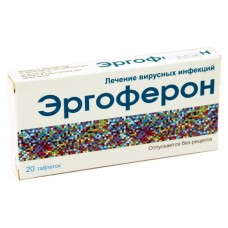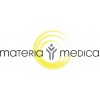Expiration date: 12/2026
The composition and form of issue:
Lozenges. 1 tablet contains active substances:
antibodies to gamma interferon of human affinity purified* 0.006 g
antibodies to histamine, affinity purified* 0.006 g
antibodies to CD4 affinity purified* 0.006 g
* applied to the lactose in the form of a mixture of three active water-alcohol dilutions of the substance diluted, respectively, in the 10012, 10030, 10050 times
excipients: lactose monohydrate, microcrystalline magnesium stearate
in the contour packaging 20 PCs. in cardboard pack 1, 2 or 5 packs.
Description pharmaceutical form:
Lozenges valium forms, with valium and chamfer white to almost white. On the flat side with the mark affixed MATERIA MEDICA, on the opposite flat side of the inscription ERGOFERON.
Pharmacokinetics:
The sensitivity of modern physicochemical methods of analysis (gas-liquid chromatography, high performance liquid chromatography, gas chromatography-mass spectrometry) does not allow to assess the content of ultra-low doses of antibodies in biological fluids, organs and tissues, that makes technically impossible the study of the pharmacokinetics of the drug Alferon.
Description pharmacological action:
Spectrum of pharmacological activity of alferon includes antiviral, immunomodulatory, antihistamines, anti-inflammatory.
Experimentally and clinically proven efficacy of alferon components in viral infectious diseases: influenza A (seasonal flu, avian flu A/H5N1 and swine influenza H1N1) and influenza, acute respiratory viral infection (caused by parainfluenza viruses, adenoviruses, respiratory syncytial viruses, coronaviruses), herpes-virus infection (labially herpes, ophthalmic herpes, genital herpes, herpes zoster, varicella, infectious mononucleosis), acute intestinal infections of viral etiology (caused by caliciviruses, coronaviruses, rotaviruses, a retrovirus), enteroviral and meningococcal meningitis, hemorrhagic fever with renal syndrome, tick-borne encephalitis.
The drug is used in complex therapy of bacterial infections (pseudotuberculosis, whooping cough, yersiniosis, pneumonitis of different etiologies, including atypical pathogens (Mycoplasma pneumoniae, Chlamydophila (Chlamydia) pneumoniae, Legionella spp.), it is used for prophylaxis of bacterial complications of viral infections, prevents the development of superinfection. The use of the drug in pre - and post-vaccination period increases the effectiveness of vaccination provides nonspecific prevention of ARVI and influenza in the time of formation of postvaccinal immunity. Alferon has a preventive efficacy against SARS agrippinae etiology, prevents the development of intercurrent diseases in postvaccinal period.
The components included in a drug have the same mechanism of action in the form of increased functional activity of CD4 receptor, the receptors for interferon (IFN)-&gamma and histamine, which is accompanied by a pronounced immunotropic effect.
It was experimentally proved that:
1. Antibodies to interferon-gamma increases the expression of IFN-&gamma, IFN &alpha/&beta, and related interleukins (IL-2, IL-4, IL-10 etc.) improve ligand-receptor interaction IFN, reduced cytokine status normalize the concentration and functional activity of natural antibodies to IFN-&gamma, an important antiviral factor in the natural tolerance of the body to stimulate interferonogenami biological process: induction of expression of antigens of major histocompatibility complex I, II types and Fc-receptors, the activation of monocytes, stimulation of the functional activity of NK cells, regulation of synthesis of immunoglobulins by activating a mixed Th1 and Th2 immune response.
2. Antibodies to CD4, likely as allosteric modulators of this receptor to regulate the functional activity of CD4 receptor, which leads to an increase in functional activity of CD4-lymphocytes, the normalization of the immunoregulatory index CD4/CD8, and subpopulation structure of immunocompetent cells (CD3, CD4, CD8, CD16, CD20).
3. Antibodies to histamine modify vitaminzawisimah the activation of peripheral and Central H1-receptors and thus reduce the tone of bronchial smooth muscle, decrease capillary permeability, which reduces the duration and severity of rinorea, swelling of the mucous membrane of the nose, coughing and sneezing, and also reduces the severity of the infectious process related allergic reactions by suppressing histamine release from mast cells and basophils, production of leukotrienes, synthesis of adhesion molecules, reduction of chemotaxis of eosinophils and platelet aggregation in response to contact with an allergen.
The combined use of the components of complex preparation is accompanied by increased antiviral activity of its components.
Indications:
- prevention and treatment of influenza A and b (including the avian influenza A/H5N1 and swine flu H1N1)
- prevention and treatment of acute respiratory viral infections caused by parainfluenza virus, adenovirus, respiratory syncytial virus, coronavirus
- prevention and treatment of herpes viral infections (labially herpes, ophthalmic herpes, genital herpes, chicken pox, herpes zoster, infectious mononucleosis)
- prevention and treatment of acute intestinal infections of viral etiology (caused by calicivirus, adenovirus, coronavirus, rotavirus, enterovirus)
- prevention and treatment of enteroviral and meningococcal meningitis, hemorrhagic fever with renal syndrome, tick-borne encephalitis
- complex therapy of bacterial infections (pseudotuberculosis, whooping cough, yersiniosis, pneumonitis of different etiologies, including caused by atypical pathogens (Mycoplasma pneumoniae, Chlamydophila (Chlamydia) pneumoniae, Legionella spp.)
- prevention of bacterial complications of viral infections, prevention of superinfection.
Contraindications:
Increased individual sensitivity to product components.
Application of pregnancy and breast-feeding:
Safety of use of Alferon during pregnancy and lactation has not been studied. If necessary, the appointment of the drug should take into account the ratio risk/benefit.
Side effects:
Possible reactions of individual hypersensitivity to the drug components.
Drug interactions:
No incompatibilities with other drugs to date is not registered.
Method of application and dose:
Inside. The tablet should be kept in your mouth without swallowing, until completely dissolved. One reception — 1 tab. (not during meals).
Children 6 months. In appointing the drug to children younger age (from 6 months to 3 years) it is recommended to dissolve the tablet in a small amount (1 tablespoon) of boiled water of room temperature.
Treatment should start as early as possible, when the first signs of acute infection, according to the following scheme: in the first 2 hours the drug is taken every 30 min, and then for the first exercise of day 3 reception at intervals of time. 2 days and then take 1 table. 3 times a day until complete recovery.
For the prevention of viral infectious diseases on the table 1-2. a day. The recommended duration of preventive course is determined individually and may be 1-6 months.
If necessary, the drug can be combined with other antiviral and symptomatic drugs.
Overdose:
In case of accidental overdose dyspepsia caused by members of the drug fillers.
Special instructions:
The preparation includes lactose, and therefore it is not recommended to appoint patients with congenital galactosemia, syndrome of malabsorption of glucose or galactose, or congenital lactase deficiency.
Effects on ability to drive a motor vehicle and operate machinery. Has no effect.


